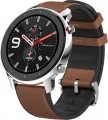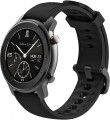Size
The size of the display installed in the gadget; for round screens, respectively, the diameter is indicated.
A larger screen, on the one hand, is more convenient to use, on the other hand, it significantly affects the dimensions of the entire device, which is especially critical for wearable gadgets. Therefore, manufacturers choose the display size in accordance with the purpose and functionality of each specific model — so that there is enough space on the screen and the device itself is not too bulky.
It is also worth mentioning that screens with a similar size may have different aspect ratios. For example, traditional smartwatches are usually equipped with square or round panels, while in fitness trackers, screens are often made elongated in height.
Screen resolution
Screen size in dots (pixels) horizontally and vertically. In general, this is one of the indicators that determine the image quality: the higher the resolution, the clearer and smoother the picture on the screen (with the same size), the less noticeable are the individual dots. On the other hand, an increase in the number of pixels affects the cost of displays, their power consumption and requirements for a hardware platform (more powerful hardware is required, which itself will cost more). In addition, the specifics of using smartwatches is such that there is simply no need to install high-resolution screens in them. Therefore, modern wrist accessories use displays with a relatively low resolution: for example, 320x320 with a size of about 1.6" is considered quite sufficient even for premium watches.
PPI
The density of dots on the screen of the gadget, namely, the number of pixels that are on each inch of the panel vertically or horizontally.
The higher the PPI, the higher the detail of the screen, the clearer and smoother the image is. On the other hand, this indicator affects the price accordingly. Therefore, the higher the density of points, the more advanced, usually, this gadget is in terms of general capabilities. However, when choosing a screen, manufacturers take into account the general purpose and functionality of the device; so that even a small number of PPIs usually does not interfere with comfortable use.
Device charging
The method of charging the battery provided in the gadget.
—
MicroUSB. Charging via standard microUSB port. The main advantage of this option is the ability to charge from any microUSB cable or charger with such a connector, not necessarily branded. On the other hand, the connector itself is quite large by the standards of wrist devices and can significantly affect the increase in the dimensions of the gadget.
—
USB type C. A compact version of the USB interface with a reversible design that allows the plug to be inserted in either direction. The USB type C specification provides for a number of advanced power options - in particular, various fast charging technologies have been developed for this connector.
-
Branded connector. Charging via a cable that connects to the watch using the original proprietary interface. The other end of the cable, as a rule, has a standard interface - most often USB, which allows you to use any computer port or network adapter with such a connector for charging. Branded connectors can be smaller than microUSB, and fit better into the layout of the clock. However, for charging, as a rule, you have to use only original accessories, including branded cradles-stands, which are intended mainly for permanent stay in one place.
-
Wireless. The main advantage of wireless c
...harging technology is the absence of any connectors - which is important, given the miniature size of wrist gadgets. At the same time, this method takes more time and significantly affects the cost of the device. Note that wireless charging is not contactless: the corresponding chargers can take the form of a stand or platform on which you need to put the watch, or a magnet attached to the back cover of the gadget, etc.
- Magnetic. Charging via a cable with convex metal contacts that are magnetized to the connector on the back cover of the wearable gadget. The magnetic contact group has no gaps, which improves the dust and moisture protection qualities of the smartwatch, and the charging plug itself is attracted to the magnetic connector, eliminating the need to look for the correct position for connecting the cable.
- USB A connector. The presence of a built-in connector allows you to connect the gadget directly to the charger, laptop, power bank without using additional cables.Battery capacity
The capacity of the battery that is installed in the gadget.
Theoretically, the higher the capacity, the longer the battery can work on a single charge. However, in fact, the battery life of the gadget also depends on its power consumption, and it is determined by the specs of the display and the hardware. Therefore, only models of the same type with very similar specs can be compared in terms of battery capacity; and for an accurate assessment of battery life, it is better to focus on the directly claimed operating time in one mode or another (see below).
It is also worth mentioning that high-capacity batteries inevitably turn out to be quite heavy and bulky. So the capacity of batteries installed in wearable gadgets is also greatly limited by size and weight.
Operating time (normal mode)
The time that the gadget can work on one battery charge (or the supplied battery) in normal use.
Normal mode, as a rule, means working with a relatively low load. At this time, the display can display some data, and basic functions can also work (counting steps, periodically checking heart rate, etc.), but in any case, power consumption is low. Therefore, the operating time in normal mode can be quite impressive, up to
several weeks, or even months. However, when choosing, it doesn’t hurt to also pay attention to the stated time in active mode (see below) — especially if a long operating time is critical, or you plan to use the gadget intensively. The actual autonomy of the device will most likely be somewhere in between these two values, depending on the actual load. If only the time in normal mode is indicated for the gadget, you should choose with a certain reserve.
Bezel
Swivel ring around the round dial of the smartwatch.
Bezel exists for a decorative and protective purpose, and in many models it has additional markings and provides a number of special control options. By rotating it, you can navigate through the menu of the smartwatch, and it also simplifies interaction with the touch screen of the wearable device. On the bezel, special marks are often applied for the operation of the watch dial in the timer or stopwatch mode. The specific implementation of the features assigned to the ring depends on the specific model of smartwatch.
— Metallic. The metal bezel has high mechanical strength. Usually it is made of stainless steel.
— Plastic. A low cost version of the bezel, which is found in smartwatch models with plastic cases.
Strap Options
—
Skin. Leather straps are typical for a business style, they look rich and respectable, however, they are quite expensive. On the practical side, this material is strong, reliable and resistant to moisture; at the same time, it is quite demanding to care for, and if the appropriate rules are not followed, cracks may appear on the strap.
—
Rubber/silicone. Quite a popular material used not only for fitness trackers, but also for traditional watches. Rubber straps do not look as rich as leather ones, but they are also quite decent, while they are strong enough, durable, resistant to moisture and pleasantly felt on the hand. Silicone is similar in properties, which in appearance is practically indistinguishable from rubber. But the silicone is softer, does not pinch the hand and is more pleasant to the touch.
—
Metal. Metal straps (bracelets) are mainly made of stainless steel, but there are other options. Anyway, bracelets are highly durable and can be both light and massive, depending on the composition of the metal. It is also worth mentioning the high thermal conductivity of this material. Such a bracelet pleasantly cools the hand in the warm season, but causes the opposite effect in the cold.
—
Milanese bracelet. Metal bracelets made of links of very fine weaving (about 1 mm in size, or even less). The m
...aterial of such a bracelet may be different; most often it is steel, but more expensive metals are also found. Anyway, such a bracelet has an original appearance, and also provides good air access, allowing the skin to breathe. Among the shortcomings of Milanese bracelet, it can be noted that the links can “bite” the hair on the arm, creating discomfort.
— Textile. Usually, strong dense fabric (like nylon-based CORDURA) is used for straps, resistant to moisture, ultraviolet and other adverse factors. For some users, this material is more pleasant than other options; however, for a number of technical reasons, fabric straps were not widely used.
Many models of wearable gadgets are available with several strap options to choose from.Band Width
The width of the stock watch strap or bracelet is implied. Usually, in each specific model taken, this value is limited by the size of the standard lugs. A wider strap than the lugs allow cannot be installed. But the strap of a smaller width is quite possible to use. Of course, you need to take into account that an overly thin strap with a large diameter watch will not look quite harmonious. Most often, the width of the strap is directly related to the diameter of the dial. As a standard, the width is calculated using the formula: ½ x D, where D is the diameter of the dial. That is, if the dial diameter is 40 mm, then the perfect strap width in this case is 20 mm.

